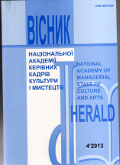Traditional wedding ceremony and the dynamics of its transformation: wedding symbols and after the wedding stage
DOI:
https://doi.org/10.32461/2226-3209.4.2013.138011Keywords:
traditional wedding ritual, dynamics, wedding ritual, symbolism, transformations, family, ritual, loaf, tradition,Abstract
This paper deals with the transformation and the dynamics of the traditional wedding ceremony highlighting the symbolism of wedding and after wedding stages in the regions of Ukraine. It is analyzed the transformation of wedding stages in the twentieth century and discovered specific changes in the structural outline of ritual (disappearance or merger of some parts of the ritual wedding ceremony, some reduction of wedding ritual events, increasing the proportion of specific wedding entertaining ceremonies). Reducing of wedding drama takes place by loss of some traditional links. Some rituals, traditionally accompanied by songs and rituals without song comments, disappear from the wedding ceremony. The disappearance of the first directly affected the symbolic system. As a ritual disappeared from an active existence, wedding songs from this ritual disappeared too or, in the best case, "migrated" to another ritual. These rituals preserve symbolic tradition at the level of verbal dialogue, at the level of ritual actions realities that actualize more or less symbolic semantics of wedding components. With the disappearance of certain parts of the wedding ritual polyphonic singing, people's well-established system of values and symbols is also destroyed. A number of transformational developments of Ukrainian marriage ceremony is described. We analyze the characteristic changes in the structural outline of the wedding ceremony in all regions of Ukraine: extinction and merger of some rituals of the wedding ceremony, the reduction and schematization of individual and wedding ritual events, and evergrowth of wedding entertainment rituals. In today's wedding, the most actively takes place the transformation of functional load of ritual events as well as focus shift from magical and legal functions for entertaining and spectacular. Humorous, not serious, and sometimes, imitative character of still common in wedding customs as "runaway", "hiding" or kidnapping the bride is very obvious. Some ceremonial events and rituals have become extremely imitative (pantry). Along with the disappearance of ceremonial events, that posit aggressive relationship of families in the twentieth century, consonant verbal texts also disappear from living existence. Ritual modifications determine changes in filling song accompaniment, which, in turn, "corrects" imaginative world of Ukrainian wedding: functional shifts have influenced the tone of the music and the conceptional and emotive characteristic of particular symbols. Nawdays we can observe tendencies of careful reconstruction and revival of ancient rituals that are stimulated by continuing increase of interest in folk traditions. Preservation of archaic traditional rituals has being carried out thanks to its to the processes of the revival of traditional rituals in an environment where obstacles for its existence disappear.Downloads
Published
Issue
Section
License
Authors who publish with this journal agree to the following terms:
1. Authors retain copyright and grant the journal right of first publication with the work simultaneously licensed under a Creative Commons Attribution License International CC-BY that allows others to share the work with an acknowledgement of the work's authorship and initial publication in this journal.
2. Authors are able to enter into separate, additional contractual arrangements for the non-exclusive distribution of the journal's published version of the work (e.g., post it to an institutional repository or publish it in a book), with an acknowledgement of its initial publication in this journal.
3. Authors are permitted and encouraged to post their work online (e.g., in institutional repositories or on their website) prior to and during the submission process, as it can lead to productive exchanges, as well as earlier and greater citation of published work (See The Effect of Open Access).


